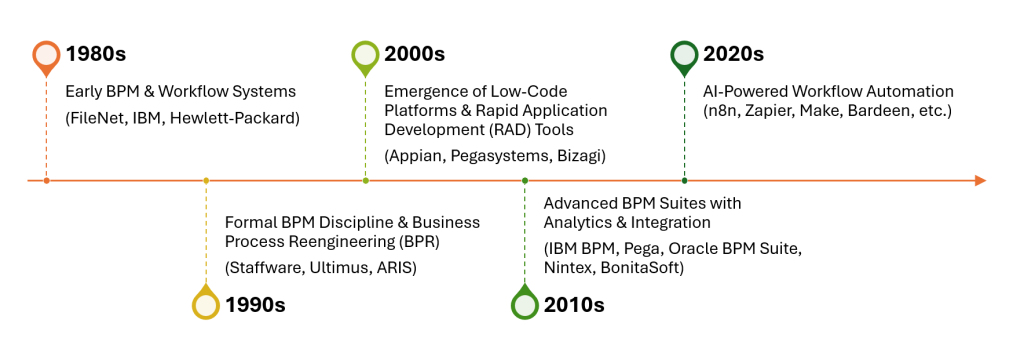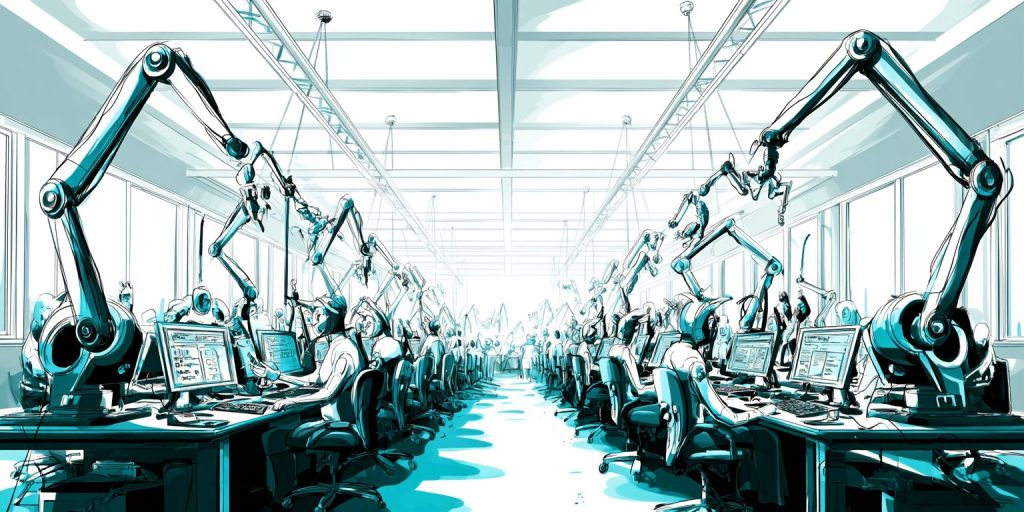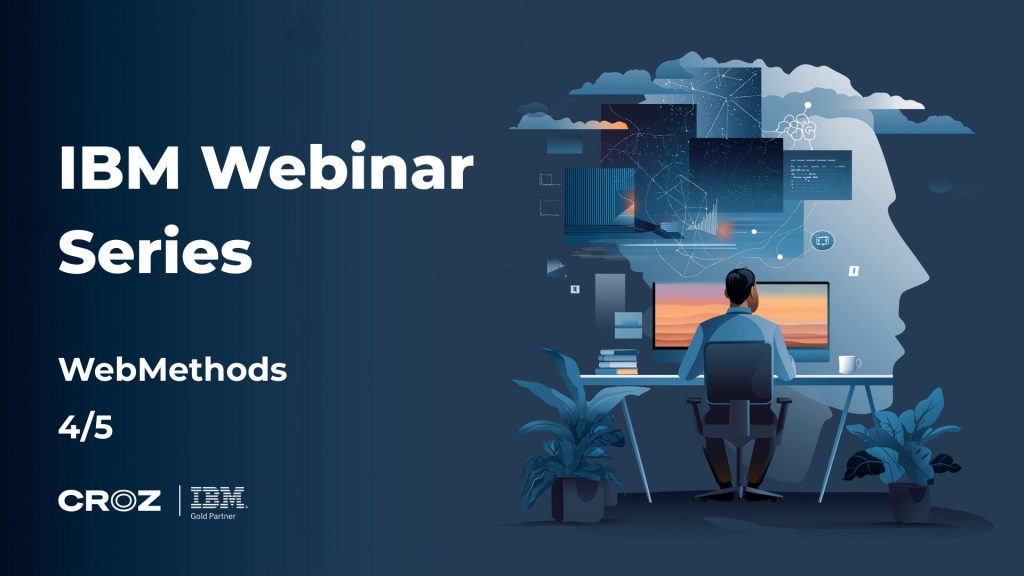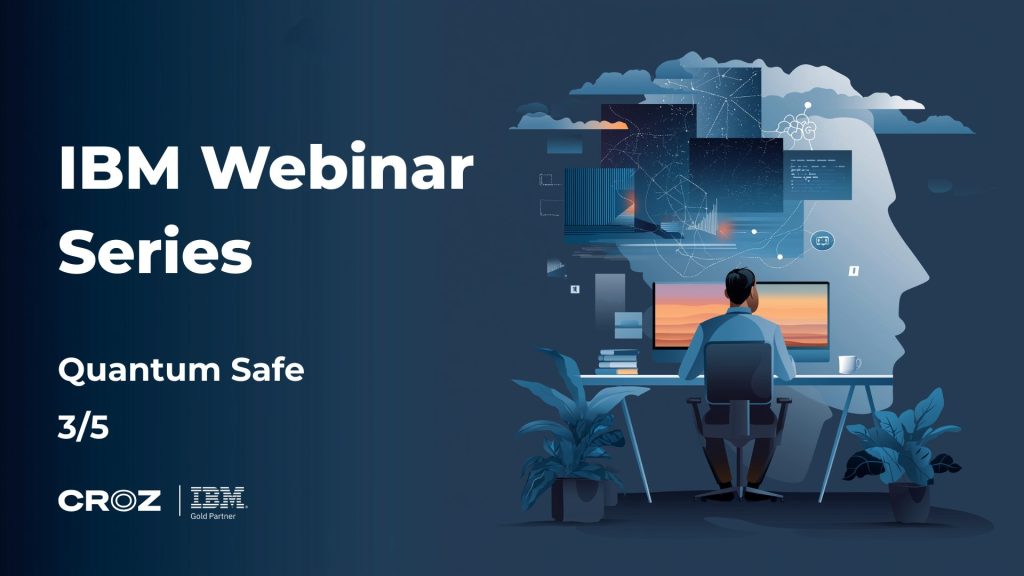The landscape of business automation is shifting rapidly. From code-heavy tools of the 90s to drag-and-drop low-code builders, and now to adaptive AI agents.
The Evolution of Automation Tools: From Workflows to Intelligence
The roots of BPM (Business Process Management) software go back to the 1980s and 1990s, when they existed as code-heavy workflow management systems.
In the 2010s, the rise of low-code development empowered “citizen developers” (business users and analysts) to build workflows using drag-and-drop interfaces with minimal coding.
And since 2023, we’re experiencing yet another big shift – led by AI workflow automation.

Workflow automation tools like n8n, Zapier, Make, Workato, and many others have rapidly evolved, now integrating large language models (LLMs) and autonomous agents with low-code/no-code capabilities, fundamentally redefining what “automation” means.
We’re no longer just moving data from point A to point B with rigid, if-this-then-that rules. Modern platforms can reason, decide, and even adapt in real time.
This shift from rule-based logic to AI-powered decision-making is quietly transforming how businesses operate behind the scenes.
What Low-Code Automation Platforms Solved Before AI
Even before AI entered the picture, low-code automation platforms had major advantages:
- Quick and easy development: Drag-and-drop workflow builders and pre-built components made it simple to build logic without code. In fact, low-code tools have been shown to reduce development time by up to 90%.
- Prebuilt integrations: Most platforms came with hundreds of ready-made connectors for existing systems like CRM, ERP, ticketing systems, databases, etc.
- Reduced dependency on IT: Business users could now design, test, and deploy automations without waiting on development resources.
But they were still based on rigid logic and structured inputs. And users wanted a workflow that could think. With the arrival of AI, this is no longer just a hypothetical – it’s exactly what the newest generation of automation tools is starting to deliver.
What Changed: The Forces Redefining Automation AI
1.AI Became Plug-and-Play
APIs from providers like OpenAI and Anthropic have made language understanding accessible. Low-code platforms like n8n have added AI-powered components for summarization, classification, and generation—without requiring ML expertise. This directly enabled a new class of AI workflow automation.
2. From Static Rules to Adaptive Reasoning
Agent frameworks like AutoGen, CrewAI, and LangChain introduced autonomous agents that can plan, reason, and perform multi-step tasks. Workflows evolved from scripts into intelligent processes, reflecting the full potential of AI workflow automation.
3. User Expectations Shifted
Tools like ChatGPT raised the bar. Users now expect systems to handle exceptions, understand vague input, and respond naturally. Intelligent automation became not a luxury, but a requirement.
A Paradigm Shift: From Deterministic to Adaptive Workflows
Traditional automation was deterministic: If X equals Y, then do Z.
if date is after [due_date] → trigger a report. if report status is “Approved” → send an email.
It often struggled with exceptions and ambiguities and it could not make decisions without explicit human programming.
Modern automation is probabilistic and adaptive. Thanks to LLMs and smart agents, workflows can now handle tasks that used to require human intuition:
- Analyze sentiment or tone (e.g. frustrated vs. satisfied customer emails)
- Interpret users’ intent even if they don’t phrase it perfectly
- Understand vague or unstructured data
- Search semantically, not just by keywords, even if terminology doesn’t match exactly
- Generate natural language responses, without predefined templates
- Chain tasks dynamically – AI agents act as intelligent coordinators that chain together multiple steps and adapt as they go
Old paradigm:
“If status = approved, send template #3.”
New paradigm:
“Analyze message tone. If positive, generate a personalized follow-up using relevant context from the knowledge base.”
Automation design now requires new thinking: stop building rigid rules – start designing for context, variability, and reasoning.
A Real Example: Smarter IT Support
What does this look like in practice? Let’s consider a real example in an IT support workflow.
Imagine your internal IT support receives dozens of emails daily. A traditional automation might check if the subject line contains a word “password” and forward the message to the credentials team. Simple, but rigid.
Now consider a more adaptive AI-driven flow:
- An email is received at [email protected].
- Sentiment is analyzed by a Triage Agent. If it’s angry, it gets escalated to human operator immediately.
- If the tone is neutral or positive, the AI agent extracts the intent (what is the person actually asking for help with?).
- Semantic Search Agent finds the most relevant internal documentation, even if the question is phrased vaguely or contains slang.
- AI Answer Agent generates a personalized, relevant response and offers next steps.
- Within minutes, a helpful answer is ready to send back, all without a human having to manually read the email or comb through documents (although, human approval step is always advised 😉).
This isn’t just faster support – it’s more intelligent, more helpful, and more customer-aware.
And the best part? If using low-code automation platform, you don’t need to write code to build it.

Business Value: Strategic Outcomes, Not Just Speed
AI-enhanced low-code platforms don’t just automate more, they automate better.
This shift unlocks more than efficiency. Consider a few of the strategic outcomes:
Higher service quality
Responses are more relevant, timely, and human-like.
A customer who writes, “Hey, VPN’s acting weird again. Can’t get in. Same thing as last week maybe?” can get an answer immediately. The system will interpret the intent (VPN access issue), lookup tickets from last week, find the article titled “Troubleshooting VPN login issues” and compose a personal, relevant answer to the customer.
Better experience:
- Sentiment-aware workflows improve customer satisfaction.
- Positive emails get auto-handled by AI. Negative ones get the human touch they deserve.
A customer who writes, “I’m really frustrated this isn’t working” no longer gets a generic ticket response. The system detects frustration, escalates the issue, and triggers a priority follow-up, all automatically.
Less mental load:
- AI handles the repetitive tasks like searching documentation or rephrasing replies, letting humans focus on edge cases and judgment.
- It’s not about replacing humans, it’s about helping them focus on what matters most.

Important Risks to Consider
With increased capability comes new responsibility:
- Data Privacy: Avoid external exposure by self-hosting LLMs.
- Hallucinations: Use Retrieval-Augmented Generation (RAG) to ground AI responses.
- Prompt Quality: Poor instructions lead to poor output. Prompt engineering matters.
- Context Gaps: AI needs structured context to operate effectively.
- Over-automation:Design the process with humans in the loop.
- Governance: Define ownership for every automation process.
Well-designed AI workflow automation balances capability with control. For a more grounded perspective on how organizations can navigate these challenges at scale, CROZ team explores them in depth in our article on pragmatic AI in enterprise.
Looking Ahead: Strategy First
Low-code automation platforms are evolving into strategic, intelligence-driven tools that can sense, understand, and act, not just execute pre-defined rules. AI-powered workflows can find patterns, personalize responses, and adapt on the fly, things older automation systems just weren’t designed for.
Companies that embrace this shift thoughtfully will gain:
- More agile operations: Processes can be adapted quickly to changing business needs without long development cycles.
- Smarter use of data: AI can detect patterns, and personalize responses using information already inside your organization
- Empowered non-technical teams: Low-code tools let business users design and improve workflows directly, reducing bottlenecks and freeing up IT for more strategic work
- Improved customer experience: From IT support to HR onboarding, intelligent automation delivers faster, more human-like interactions across internal and external touchpoints
- Reduced operational risk: Well-designed automation minimizes manual errors, ensures compliance with rules and policies, and creates a clear audit trail.
Businesses without an internal AI Workflow Automation strategy risk falling behind. A trusted implementation partner can help map out a smart adoption roadmap tailored to your needs.
Final Note
The future of automation isn’t about replacing people. It’s about building smarter systems that extend human capability.
The platforms are ready. The AI is here.
What’s missing in many companies is the strategic mindset to use them wisely.
Falls Sie Fragen haben, sind wir nur einen Klick entfernt.



